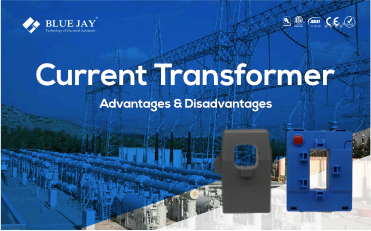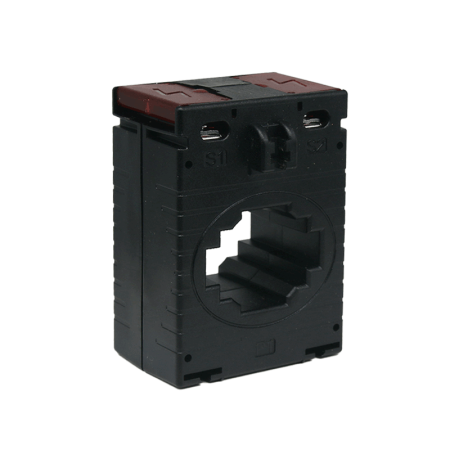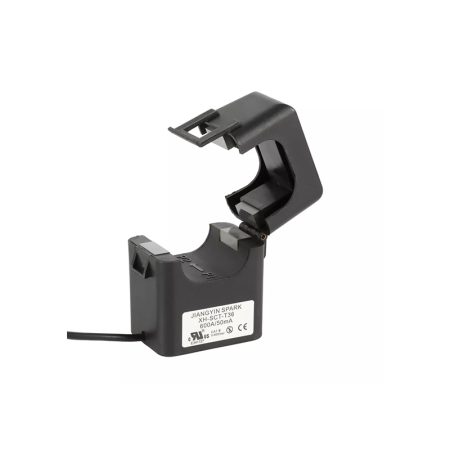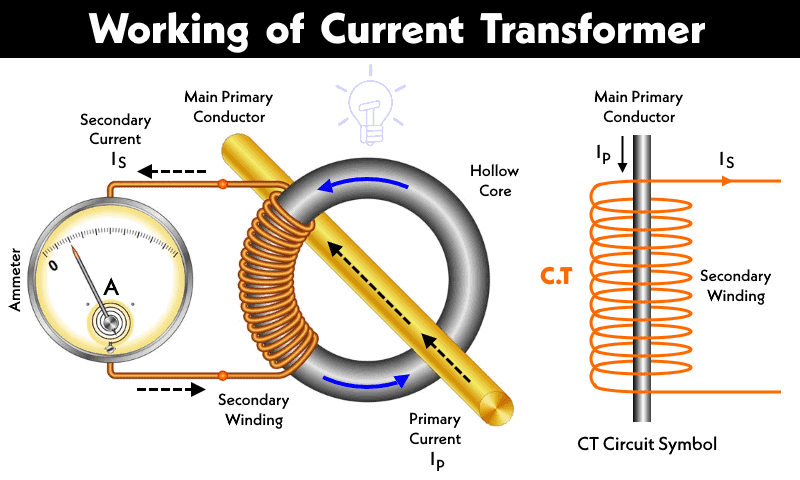
What Are Advantages and Disadvantages of Current Transformer?
As for the advantages and disadvantages of current transformer,

As for the type of current transformer (CT), there are 6 types based on different features, construction, and so on. Today, this article will introduce current transformer types in detail.
According to their construction and design features, these classifications usually reflect the internal structure and working principle of current transformers.
1. Window Current Transformers: This type of current transformer usually has an open circular or rectangular core, and the primary winding passes through this opening. Window CTs are commonly used for non-invasive current measurements because they allow the main coil to directly surround the conductor through which the current is being measured, without cutting off the circuit. They are suitable for fast and convenient current monitoring.
2. Bar Current Transformers: This type of current transformer has one or more rails around which the main coil is wound. Rails are usually made of conductive material and are used to conduct the current being measured. Bar CTs are typically used on branch circuits or electrical equipment in power systems to monitor and measure current. Their design makes them suitable for easy installation on rails.
3. Wound Current Transformers: This type of current transformer uses windings (coils) to build the dominant coil. The main advantage of wound CTs is that they can be customized with different ratios and current ratings. They are often used in applications requiring specific ratios or accuracy requirements, such as high-precision measurement and protection devices.
These classifications help differentiate between different types of current transformers to meet the needs of different applications. The selection of current transformers depends on circuit configuration, accuracy requirements, installation environment, and other factors. When selecting a current transformer, its internal structure and operating principles need to be considered to ensure it is matched to the specific application.
These current transformer types are divided, according to their application and installation environment.
1. Indoor Current Transformers: These CTs are designed for installation in indoor power systems. They typically have enclosures and insulation adapted to indoor environmental conditions and meet specifications
and safety standards relevant to indoor installations.
2. Outdoor Current Transformers: These CTs are designed for installation in outdoor power systems. They must be weather-resistant and waterproof in order to function properly in a variety of weather conditions.
Outdoor CTs often require additional protection and insulation measures.
3. Portable Current Transformers: These CTs are mobile and portable and are usually used for temporary or emergency measurements. They can be installed and removed quickly and are suitable for field measurements,
maintenance, and fault detection.
4. Bushing Current Transformers: These CTs are usually installed in the bushings of high-voltage equipment such as transformers or circuit breakers. They are designed as a built-in type to monitor and measure the current flow inside the equipment in order to protect and control the proper operation of the equipment.
These classifications assist in selecting the appropriate type of current transformer based on specific application scenarios and requirements. Different types of current transformers have different design features and specifications to adapt to different working environments and needs such as indoor, outdoor, portable, or bushing installation. When installing and using current transformers, relevant safety and performance standards must be followed to ensure their proper operation and reliability.

Current Transformers (CTs) are usually classified according to their uses and performance characteristics. This classification is formulated based on the needs of power systems and power engineering. The following are some common current transformer classifications.
1. Standard Measuring CTs: These CTs are designed to measure and monitor current to provide accurate measurements of current. They generally have high accuracy and are used in metering, instrumentation, and monitoring applications. Standard measuring CTs usually provide accurate current conversion within the rated current range and are used for energy measurement in power systems.
2. Metering CT: This is the term related to the standard measuring CTs that are used for energy measurement (such as electricity meters) to ensure accurate recording of energy consumption. These CTs often need to meet specific accuracy and stability requirements to ensure metrological accuracy.
3. Protection Current Transformer (Protection CT): The main objective of these CTs is for over-current and short-circuit protection of power systems. They often have additional features, such as high instantaneous overcurrent withstands capability and saturation characteristics, to ensure timely triggering of protective devices in the event of a system fault to prevent equipment damage or grid fault propagation.
These classifications help ensure that the right CT type is selected for a specific application, as different applications have different CT performance requirements. In addition, international and regional standards (such as IEC, IEEE, etc.) will also stipulate the performance and specifications of different types of CTs to ensure their normal operation.
Current Transformer (CT) is divided into the following two types based on their circuit status.
1. Closed Loop CT: This type of transformer is designed for applications with closed circuits. They close the circuit between the primary winding and the secondary winding, usually through a wire or connector. Closed-loop CTs are often used in applications that require high-precision measurements because they provide better linear performance and impedance matching.
2. Open Circuit Current Transformer: This type of transformer is designed for open circuit applications, that is when the secondary coil has no external load connection. Their secondary coils usually do not close the circuit but are connected to measuring equipment or monitoring systems. Open circuit CTs are typically used in situations where current flow is monitored without the need to deliver the current to the load, such as for fault detection or instrumentation measurements. In addition to circuit status, current transformers can be classified based on factors such as their purpose, accuracy, rated current, and frequency.
These classifications assist in selecting the type of transformer suitable for a specific application. It is worth noting that different regions and standards may adopt different naming and classification methods, so the specific naming details may vary.

1. Split Core Current Transformer: This type of current transformer has a core that can be split, allowing the user to wrap the core around an already existing wire. Typically, they are designed as two semi-circular sections that can easily fit over a wire without cutting the circuit. Split core CTs are often used for ease of installation and maintenance, especially when current measurement equipment is added or replaced at a later date.
2. Solid Core Current Transformer: This type of current transformer has a solid core, usually cylindrical or rectangular. They usually require running a current lead through the center hole of the core before installation, thus requiring the circuit to be interrupted for installation. Solid core CTs are often used in measurement applications that require greater accuracy and stability because their magnetic circuits are generally more continuous and the magnetic induction lines are more uniform.
This classification helps in selecting the type of current transformer suitable for a specific application, taking into account factors such as ease of installation, accuracy requirements, and application environment. Different transformer types are suitable for different measurement and protection applications, so the correct selection of transformer type is very important to ensure the normal operation and safety of the power system. Standards and specifications often specify the type and performance requirements of instrument transformers to ensure their suitability for a specific application.
AC Current Transformer and DC Current Transformer are classified according to the type of current. These classifications reflect the current transformer’s ability to handle different types of currents.
1. AC Current Transformer: This type of current transformer is used to measure, monitor, and protect alternating current (AC) current. They are typically designed to measure or monitor AC current in power systems for use in instrumentation, protection devices, control systems, and other applications. AC current transformers usually have an iron core to better transfer and transform AC current.
2. DC Current Transformer: This type of current transformer is used to measure, monitor, and protect direct current (DC) current. Relatively less common, DC current transformers are typically used in DC power systems or other applications where DC current needs to be measured. They often have special construction and materials to accommodate the characteristics of DC current. If you want to know the DC current transformer working principle, please click here.
This classification is mainly based on the type of current since AC and DC currents are very different in nature and characteristics and thus require different types of current transformers to measure them. When selecting a current transformer, you must ensure that it matches the type of current required (AC or DC) and the requirements of the application. Standards and codes often specify the type and performance of current transformers to ensure their correct operation in specific current types and applications.
Blue Jay Technology, a professional current transformer manufacturer in China, offers the following type of current transformer:
At Blue Jay Technology, you can get 4 types of current transformers that are DC Hall effect sensor, solid cord current transformer, split core current transformer, and SCT current transformer. If you are want to buy current transformer from a China manufacturer, Please contact us directly.

As for the advantages and disadvantages of current transformer,

Current transformer installation is very important to ensure accurate

A current transformer is a commonly used power measurement equipment.




